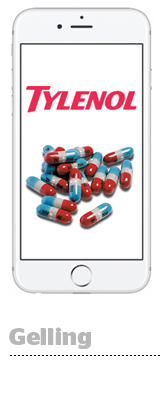
Most brands don’t want to be the first thing someone thinks of when they get a stress headache or feel pain after exercise – but Tylenol does.
As part of a recent campaign to promote the relaunch of its Rapid Release Gels sub-brand after a 2009 recall, Tylenol wanted to be top-of-mind with potential customers in their moments of need.
Tylenol refers to its target demo for Rapid Release Gels as “transitional pain sufferers,” people who aren’t dealing with a chronic pain condition but need fast pain relief after emotional or physical triggers, such as a bad day at work or an old sports injury that acts up following a run.
“And to do that, mobile was really the place we needed to play in,” said Sandy Carlson, director of customer and omnichannel initiatives at Johnson & Johnson, maker of Tylenol.
Tylenol worked with its shopper agency, Upshot, to develop an omnichannel effort to drive people into Walgreens locations.
In addition to targeting consumers using traffic app Waze with maps directing them to their nearest Walgreens, Tylenol used mobile ad platform Aki Technologies to create audiences based on specific moods and pre-shopping moments.
Aki employs a mix of data signals – location, environmental, intent, content consumption, time of day – to pinpoint consumers when they’re engaging in a particular activity and have a specific mindset, like when they’re running an errand or staying late at the office.
Tylenol employed several different moments, including targeting people on their commute, in the morning when they’re getting ready or when they’re near a Walgreens or a Walgreens competitor.
But the one that seemed to work best was the post-workout moment, either in the morning or after work. That was a validation of Tylenol’s underlying strategy, said Aki CEO Scott Swanson.
“In this case, trigger-based moments were more effective than just standard location-based targeting,” Swanson said. “This was about the consumer’s state of mind.”
It was somewhat of a surprise to Tylenol how crucial frame of mind turned out to be for its mobile targeting strategy.
Tylenol’s hypothesis was that the best time to hit its target consumer would be after an exhausting commute following a long day at work.
While the Rapid Release message did ring true with that audience, Carlson said, “we also saw other pockets of time during the day – in the morning or after a workout – when we had really strong engagement.”
When consumers visited a Walgreens location, they were met with complementary in-store messaging, including a motion-activated endcap video display next to the pain relief aisle in more than 2,500 Walgreens stores explaining how the Rapid Release gel works. The spot also ran on YouTube for 12 weeks.
Having driven people to the store with mobile, video helped seal the deal. The stores with a video endcap saw a 9% to 10% lift in sales.
The mobile campaign with Aki and Waze reached more than 25 million shoppers across five key metro markets, including New York, San Francisco, Los Angeles and Chicago. The click-through rate for the moments-based creative was .8%, which exceeded Tylenol’s CTR goal by 300%.
“That tells us people weren’t just being exposed to an ad,” Carlson said. “They were engaging to learn more about Tylenol, and they wanted to find out where to buy it.”
This post was syndicated from Ad Exchanger.

More Stories
Marketing Morsels: Hidden Valley Ranch, La-Z-Boy, Topps & More
Flashback: Jane Pauley and Deborah Norville Revisit Today’s 1989 Succession Drama
Ally Financial Revives ‘Banksgiving’ With A TikTok Twist